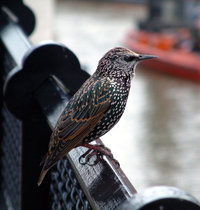Common Starling
|
|
| Common Starling Conservation status: Lower risk | ||||||||||||||
|---|---|---|---|---|---|---|---|---|---|---|---|---|---|---|
 | ||||||||||||||
| Scientific classification | ||||||||||||||
| ||||||||||||||
| Binomial name | ||||||||||||||
| Sturnus vulgaris Linnaeus, 1758 |
The Common Starling (Sturnus vulgaris), or European Starling, is a passerine bird in the family Sturnidae.
This starling is native to most of Eurasia, but has been introduced to South Africa, North America, Australia and New Zealand. This adaptable and omnivorous species has proved to be a pest in several of these countries. In Western Australia, which is starling-free, the government pays full-time hunters to patrol the border and shoot starlings as they arrive.
It is resident in southern and western Europe, but migrates from colder regions to these areas, and further south to Iberia (where it does not breed) and north Africa.
The Starling lives in a variety of habitats and can be found in any reasonable open environment from farmland to salt marsh.
These birds will eat almost anything, including farmland invertebrates and berries. This is a highly gregarious species, forming huge flocks in winter, and providing a spectacular sight as they descend into evening reed-bed roosts, often attracting birds of prey. Large roosts (exceptionally up to a million birds) can form in city centres, causing a great deal of mess from their droppings.
The Starling must be one of the most familiar of birds, with its shiny black plumage spangled with white. Confusion is only likely in Iberia in winter, when it has to be distinguished from the closely related Spotless Starling, which, as its name implies, has less spotting on its plumage. Adult males are less spotted below than adult females. Juveniles are dull brown, and by their first winter resemble adults but are browner especially on the head.
Starlings walk rather than hop. Their flight is quite strong and direct; they look triangular-winged and short-tailed in flight. In most of Europe, only the rarer and much paler Bohemian Waxwing shares this flight profile. This is a noisy bird, and a good mimic, like many of its family. In captivity, they are gregarious and love to imitate all types of sounds and speech earning them the nickname "Poor-man's Myna").
Information on care of Starlings as well as recordings of a Starling talking can be found at Starling Central (http://www.starlingcentral.net).
The Common Starling is a hole-nesting species, and has impacted on native species where it has been introduced because of competition for nest sites. Although there are approximately 200 million starlings in North America, they are all descendants of approximately 100 birds released in Central Park in the 1890s from Europeans. These starlings have created an evolutionary problem in North America since the starling prey has not adapted any type of defense. This is what makes the European Starlings severely overpopulated and the birds can now be found all through North America and Alaska. Because of such overpopulation and the threat these birds pose to songbirds, it is perfectly legal to kill starlings at any time of the year in most American states.
[1] (http://birds.cornell.edu/BOW/EURSTA/)
There are two subspecies of the Common Starling.
The Shetland Starling (S.v. zetlandicus) is a bit larger than the normal starling.
The Faroese Starling (S.v. faroeensis) is the largest (European) variant of the starling. The adult is in the winter black with blue shades, which become green in the summer.
da:Stær de:Star (Art) es:Estornino fr:Étourneau fy:Protter he:זרזיר מצוי nl:Spreeuw pl:Szpak fi:Kottarainen sv:Stare wa:Sprewe
